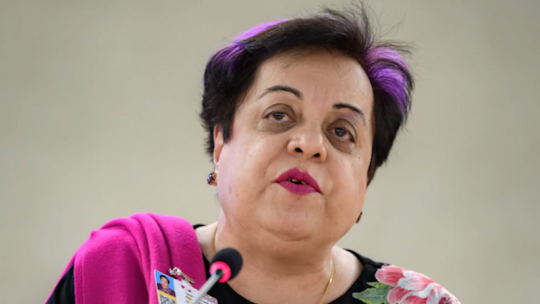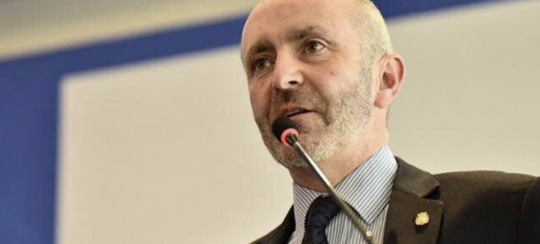#DifficultLoveStory
Explore tagged Tumblr posts
Text
Kashmir lessons from Northern Ireland peace process
By Faisul Yaseen
Sean Murray and Muhammad Yasin Malik are similar yet different.
A former member of the Provisional Irish Republican Army, Murray was jailed for 12 years for explosive offences in 1982.
Today, he is a senior member of Sinn Fein and an Irish Republican from Belfast, Northern Ireland.
Like Murray, Malik, the chairman of Jammu and Kashmir Liberation Front (JKLF), a pro-independence armed group in Kashmir, renounced violence in 1994 and took a plunge into separatist politics. However, unlike Murray, he remains imprisoned at New Delhi’s Tihar Jail and was awarded life sentence by India’s National Investigation Agency (NIA) court.


In an interview in Belfast, Murray said that the transition from the armed conflict to the political conflict in Northern Ireland was difficult.
“British government was reluctant but the Irish diaspora and the US helped pave the way to the Good Friday Agreement that gave us the political structure,” he said. “The Good Friday Agreement was a breakthrough although there still are issues.”
Murray said that the Police and the criminal justice system that were earlier seen as extensions of unionism had improved.
On whether there was any chance of people in Northern Ireland taking up arms again, he said, “Not in the foreseeable future.”
Murray though was quick to add that when they launched an armed rebellion, it was the “right thing to do.”
He said that having British soldiers on Northern Ireland streets would be a disaster.

“I have seen friends in graveyards. I have had sleepless nights. To every action there is a reaction. No one explains the fear of the conflict, the fear that you are going to die,” Murray said.
Like him, Malik too saw most of his JKLF members killed, but ironically after renouncing violence.
Similarities and Dissimilarities
There are various similarities between the Northern Ireland and the Kashmir conflict but the way Britain and India have dealt with the two conflicts does not derive any parallels.
While Britain responded to the violence perpetuated by the Irish Republican Army (IRA) with the devolution of more powers to Northern Ireland, New Delhi reacted to the armed insurgency in Kashmir with the abrogation of its semi-autonomous status.
The Troubles led to the Good Friday Agreement of 10 April 1998, and the St Andrews Agreement of 13 October 2006 but would Kashmir insurgency similarly shift from a violent means to a peaceful dialogue process, leading to some sort of resolution, remains to be seen.

Salil Tripathi in his opinion piece ‘Where the Irish and Kashmiri stories converge and diverge’ for the ‘The Mint’ writes, “Northern Ireland elects its own first minister and there is significant devolution of power (not unlike the spirit of Article 370), and governments are formed based on power-sharing.
“In Northern Ireland, former first ministers are not under house arrest without being charged; the internet has not been shut down; troops are not marching and the streets not deserted; and nobody – not Catholic revellers, nor Protestants marching provocatively during the season - fear being shot at by pellet guns and getting blinded.”
Kashmir Conflict
If Shakespearean drama Hamlet were to be about India-Pakistan relations, the Prince of Denmark has to be Kashmir.
The north-Indian region of Kashmir has been a bone of contention between India and Pakistan since 1947 and people of Kashmir have borne the brunt of this conflict for the past seven and a half decades.
Since late 1980s, the conflict has turned uglier with human rights organisations putting the number of people killed at 70,000, many more thousands wounded, over 8500 subjected to enforced disappearances, hundreds of women raped, and thousands of children orphaned.

Intermittently, in the past, there have been efforts to foster friendly relations between New Delhi and Islamabad, and also between New Delhi and Kashmir, but, of late, there have not been any major peace and reconciliation efforts. For the past over 10 years, New Delhi has been dealing Kashmir with an iron fist with policies like ‘Operation All-Out’ against the local insurgents and clamping down on the separatist groups.

With the focus shifting from developmental activities to anti-militant and anti-separatist activities, the governance has taken a hit.
Kashmir for Northern Ireland-type Resolution
In Kashmir, both the pro-India as well as the pro-independence leadership has called for the resolution of the Kashmir issue on the pattern of Northern Ireland.
Three-time chief minister of Jammu and Kashmir, Farooq Abdullah pitched for the resolution of the Kashmir issue on the model of Good Friday Agreement.

“Like Northern Ireland, the only roadmap forward is two Kashmirs with an easy border and autonomy,” Business Standard quoted him as saying during a discussion organised by South Asia Institute at the School of Oriental and African Studies in London.
“Kashmir can be solved if both the nuclear powers – India and Pakistan - realise that whatever solution has to emerge, everybody will not accept it,” he said.
Abdullah’s archrival in politics and Kashmir’s head priest, Mirwaiz Umar Farooq, who heads the All Parties Hurriyat Conference (APHC), a conglomerate of various Kashmiri separatist groups, in an interview to Reuters said, “I think Kashmir and Northern Ireland do have similarities – the fact that it’s the will of the people to be their own masters and not under the hegemony of one party or the other.

“If you look at Northern Ireland, it has moved from confrontation to cooperation. That is what we have to do.”
Not only in Kashmir, the Northern Ireland conflict resolution process has also found takers in Pakistan.
Pakistan’s former human rights minister, Shireen Mazari also proposed the Northern Ireland model as a possible solution to “Kashmir dispute”.

At a webinar organised by Islamabad Policy Institute, a prominent think tank of Pakistan, Mazari said, “Pursuing the model of the Good Friday Agreement in 1998 brought together all parties to the conflict in Northern Ireland and ended decades of violence. The Northern Ireland model can be a possible approach to resolving the Kashmir dispute.”
Abrogation of Article 370

On 5 August 2019, Government of India (GoI) decided to annex the semi-autonomous Kashmir region while abrogating Article 370 of the Indian constitution.
For over a year, people did not have access to the internet.

The academic activity in schools, colleges, and universities suffered with students unable to attend the classes due to undeclared curfew, shutdowns, and a civil disobedience movement against New Delhi’s unilateral decision of stripping the region of its special status.
The business activity in the region suffered a body blow with the Kashmir economy witnessing loss worth billions of Indian rupees.

GoI not only downgraded the status of the semi-autonomous region but also divided it into two union territories – the Muslim-majority Jammu and Kashmir, and the Buddhist-majority Ladakh, both controlled directly from New Delhi without any role of local governance.

The development of the region, the premise on which the GoI took this decision, is completely missing from Kashmir.
People of Kashmir believe that the real reason for abrogating the special status of the region is their distinct ethno-religious identity.
New Delhi’s decision of doing away with the special status of Kashmir has complicated the matters further with disenchantment spreading even among the pro-India political parties in the region.
Even three former chief ministers, Farooq Abdullah, Omar Abdullah, and Mehbooba Mufti remained in detention for around a year and have been placed under house arrest from time to time.

Issue of Identities
Clearly, India has not been able to handle its ethno-religious identities well.
Contrary to this, the United Kingdom seems to have handled the experiment of nationalities within in a better way.
While India stripped the special semi-autonomous status of Kashmir and is on a path of ‘Ek Vidan, Ek Pradan, Ek Nishan’ (One constitution, one state head, and one flag), democratic movements in the UK led to autonomy and devolution of powers.

Over the years, the UK has yielded benefits by allowing devolution of powers in Scotland, Northern Ireland, and Wales with democratic movements from the ground up. Time to time referendums have also been conducted.
The British way of dealing with the issue of nationalities within, devolution of powers, and autonomy has proved to be successful.
That the capital centres of London, Edinburg, Cardiff, and Belfast have come to co-exist in a four-country kingdom explains why “military might” should not be used to subdue a population and hold a region hostage.

The second half of the 20th century witnessed violence of the Irish Republican Army in Northern Ireland and counter-violence.
However, the repercussions of hardline stances taken by the state as well as the population were damaging.
It is praiseworthy how, despite differences, each political party in the United Kingdom has people who stand for the devolution of powers and how their decisions are not driven by a fanatical minority.
The thinking has been that the people at large – the majority – should be consulted, but at the same time, the minority not forgotten.
In the Northern Ireland conflict, the players on both sides came to the negotiating table, saving thousands of lives in the process.
This is an approach that Kashmir also needs to adopt to save the region from a nuclear war, something that almost started after a 20-year-old Kashmiri youth, Adil Ahmad Dar rammed an explosive-laden vehicle into the convoy of the Indian paramilitary forces on 14 February 2019, killing 40 Indian soldiers.

With the warring factions adopting the hardline approach on Kashmir, the developmental activities of the region including healthcare and education have been hampered while people continue to get killed in the mindless violence every day.
As often the structural violence is government-induced, the Indian state has lost the Kashmir argument both on greed and grievance debate.
Peace a Process, Not an Event
Jonathan Powell, a central figure in the construction of Britain’s foreign policy under Tony Blair and his chief negotiator in the Northern Ireland peace talks in his book ‘Great Hatred, Little Room: Making Peace in Northern Ireland’ wrote that there was a craving for peace not just in Northern Ireland but Britain too that led the peace process forward.

“By the early 1980s, people on all sides in Northern Ireland were becoming weary of the cycle of blood, and the pointlessness of violence was clear. The IRA realised that they could not win militarily, and the British Army knew that, while it could keep a lid on violence ‘at an accepted level’, it could not win either. Everyone started to look for the exits.”
He stressed that the peace process was not a one-time thing but something that needed to be carried forward with planning and care.
“Breakthrough agreements are the beginning not the end of negotiations. Peace is a process, not an event,” Powell writes.
Powell’s words resonate among the people working on the peace process in Kashmir.
While states are very protective of their borders, most groups are not.
A British national, Tahir Aziz, who leads the work of Conciliation Resources on South Asia said that his organisation wants to “promote spaces” for the people to “think and talk”.

“We try to help people in Kashmir, India, and Pakistan find non-political ways to talk about things. People have been using media outlets and films to talk about the issues of governance and security,” he said.
Conciliation Resources started work on Kashmir in 2003-04 and by 2007, the organisation was spending money on practical exercises on either side of the Line of Control (LoC), the de facto border that divides Kashmir into the Indian and Pakistani administered parts.
By 2008, the Confidence Building Measures like the cross-LoC trade had started between India and Pakistan.
The trade continued even after the Mumbai attack of November 2008 in which 170 people were killed.
While holding the government to account these days is considered anti-national and anti-government while the act is labelled as treason, institutions play a key role in peace processes and the interaction of the people with these institutions plays an even greater role.
Aziz said that one of the main things that helped de-escalate violence in Northern Ireland was the police reforms.
Former Superintendent of Police and counter-terrorism expert, Ken Pennington could not agree more.

“Police have a plan, but militants have a cause. Sometimes violence is the only agency and criminalisation of violence doesn’t help. The state has a moral obligation to human rights,” he said. “Conflict isn’t black and white, but grey, murky, and moving. Folding a murdered colleague’s uniform has been the hardest thing for me.”
While the peace process finds many takers both in Northern Ireland and Britain, some sections feel the dice are loaded in favour of the Irish nationalists.
Tom Roberts, a former member of the pro-state Ulster Volunteer Force, who served 13 years in jail, said, “An Ireland at Sinn Fein terms isn’t acceptable. The Sinn Fein’s aggressive pursuit of constitutional change does not improve the situation.”

According to him, Northern Ireland was one of the most law-abiding societies till 1968.
“We couldn’t have risen as bad people one fine morning,” Roberts said.
Endless Peacekeeping Trap
The peaceniks have to be careful about the peace processes as peace building often witnesses fatigue.
Editor of Accord, Alexander Ramsbotham said that sometimes there is not a clash of historical facts but a clash of myths.

There is a phrase ‘Save Georgia from the Georgians’ but there is also another phrase, ‘a thoughtful person is worth a thousand fanatics,’” he said.
Peace processes often witness an increase in the number of proxy peace actors and conflict entrepreneurs, leading to wars within wars.
In the Balkans, Sudan, and Myanmar, the peace processes were pushed and hence did not last long.
On the other hand, the peacekeepers in the UN missions do not even leave their barracks, making the critiques of peace building weary of the endless peacekeeping trap.
They feel expressions of distrust, pessimism, and even cynicism about liberal peacebuilding have become common and they resent expatriates from imposing their ideas in a manner both disrespectful and humiliating.
The peace builders have to keep the balloon analogy of expanding space slowly and slowly in mind.
In Japan, when vases are broken, the broken parts are joined and the vases repaired with gold-coloured adhesive or even gold. In Cyprus, the sewerage system led to dialogue. The Srebrenica massacre happened just 26 years ago in an emancipated and educated Europe, making it all the more important for peacemakers to stay vigilant of the spoilers.
As conflicts are not frozen, peace processes cannot be frozen either.
A Difficult Love Story
While the people affected by conflicts want to reap the benefits of peace, there are also certain spoilers.
Director of Causeway Institute for Peacebuilding and Conflict Resolution International, Kingsley Donaldson said that both the Irish and the British were dreamers but some people on both sides wanted to rock the way.

“Our peace process is like calling time out. Brexit has not helped either. The politics of both Ireland and England affect us. There is absence of violence rather than presence of peace. We live on constructive ambiguity. Nothing is agreed until everything is agreed,” he said.
Donaldson calls for investing more in civil society in Northern Ireland.
“We were tending to our wounds. Today we are tending to our scars. We carry a grudge. However, there has been a transition in policing and justice, which are now much more reflective of society. The energy and engine of our past is shaping our future. After all, the British ran an empire without the internet and the telephones,” he said. “In Northern Ireland, we are in a very difficult love story.”
Women Power
Donaldson credits women for having stepped up and making the credible impact in the Northern Ireland peace process.
One such woman is Avila Kilmurray, the Migration and Peacebuilding Executive of the Social Change Initiative.

“Women at the grassroots in Northern Ireland refused to be sidelined and mobilised for the peace process. They had to be smart to know what happens after peace negotiations, what happens after a rollback, to ensure what happens in the implementation phase while sitting in the negotiations phase, and to tap the global network of people who could help them influence,” she said.

Like Kilmurray, Sara Cook, a social worker who worked on conflict response, peace building, and mediation in Northern Ireland, said, “When the British soldiers were in Northern Ireland, there was not much talk of peace. So, I worked with the wives of British soldiers and family members of the Irish Republican Army. We connected the families of the two together. That created an ‘I own it’ atmosphere. We also encouraged inter-generational discussions.”
The United Nations’ Resolution 1325 also calls for the role of women in peace processes.
Political and Religious Toxicity
While women played a positive role in the Northern Ireland peace process, religion and politics have often been toxic.
What do you do with the legacy of the past conflicts?
According to Reverend Gary Mason, who spent decades ministering to Protestant loyalists and Catholic nationalists during Northern Ireland’s conflict said that toxic politics and toxic religion has shaped the place for too long.

“The toxicity of memory will pass on from generation to generation. It was the words not the machines that created Auschwitz,” he said. “The state of politics actually reflects the state of our souls.”
Reverend Mason calls for addressing the structural problems leading to the killings instead of trying to stop the killings.
“Laws are important but laws can’t heal, facts are important but facts can’t heal,” he said.
Role of Media
There is a great proverb that until the lions have their own historians, the history of the hunt will always glorify the hunter.
The objectivity and partisanship of the media in reporting conflict plays an important role in how peace processes shape.
Jean Seaton in her book ‘Pinkoes and Traitors: The BBC and the nation 1974-1987’ writes about the Northern Ireland conflict and peace process.

Delving into how the British Broadcasting Corporation (BBC) reported the Northern Ireland conflict, she writes: “At the start, the BBC was unthinkingly on the side of order in Northern Ireland. Yet, the legitimacy of this order was contested and its exercise seen as unjust by the Catholic population. This was compounded by the situation the BBC faced in London. By 1976, Parliament and Labour and Conservative governments were more of less united in their approach to the crisis (although Labour was committed to a policy that Jonathan Powell, the then chief of staff for Tony Blair’s Labour government had to unpick eventually as a precondition of negotiations in the 1990s) while the ‘nation’, at least in Northern Ireland, spiraled into ever more monstrous division. The BBC was exposed because of this cross-party consensus in Westminster, which meant that any opposing views came from beyond the parliamentary system. It could look as if the BBC were encouraging them, yet was obliged to reflect the swelling disagreement on the ground in Northern Ireland. It appeared as if it was sponsoring opposition rather than reporting it. The Corporation is always in difficulty when an issue concerns the integrity of the British state, which the Troubles precisely did.”
By and large, the British media has covered the Northern Ireland conflict and peace process fairly objectively.
Laura Noonan in her article, ‘You have to be violent to be heard: Northern Ireland’s teens take to the streets’ for the Financial Times writes: “I grew up 200 miles south of Belfast. Northern Ireland’s grass is the same distinctive green as the fields of the Irish Republic where I spent my childhood. Its dramatic coastline evokes the same feeling as Connemara’s. Belfast has a zone of shiny, modern apartments and offices, the Titanic Quarter, not unlike Dublin’s Docklands. And yet, for all the familiarity, so much about Northern Ireland feels foreign.

“It’s not just the Union Jack flags that weave their way over and back across the Shankill Road, 15 minutes’ walk from Belfast’s main shopping street. It’s not the enormous murals of men in balaclavas holding automatic rifles, a sight that still unnerves me. It’s not the practicalities of a different currency, different road signs, and different speed limits. It’s more the sense of the place and my feeling of otherness within it.”
The US Role
Like the role of the media in highlighting the Northern Ireland conflict, the United States, particularly during the tenure of President Bill Clinton also played a positive role in the peace process between Northern Ireland and Britain.

Roger MacGinty in his article ‘American Influences in the Northern Ireland Peace Process’ for the Centre For Digital Scholarship’s UN Libraries Journal writes that traditionally, US government interest in Northern Ireland has been minimal, which makes the level and the extent of the interest shown during the peace process of the 1990s quite remarkable.

“A number of Irish-American entrepreneurs had become significant players in corporate America. They were also allies of Bill Clinton, and had been active in his 1992 presidential election campaign. They pressed Clinton to make a number of commitments on Ireland during his election campaign, and after his election, began briefing the White House on Ireland. In September 1993, the significance of this lobby was revealed when the IRA observed a seven day ceasefire to coincide with a fact finding visit made by a group of prominent Irish-Americans to Ireland. The most tangible sign of US interest in the peace process came with President Clinton’s visit to London, Belfast, Derry and Dublin in late November 1995. The visit was very much a celebration of the peace process,” he wrote in the journal.
Like Northern Ireland, people in Kashmir too have been craving for the US intervention for the resolution of the 77-year-old dispute. The call for US intervention in Muslim Kashmir is quite contrary to the rest of the Islamic world where the US intervention is often resented.
Navnita Chadha Behera in her report ‘Kashmir: Redefining the US role’ for the Brookings writes, “Beyond some public pronouncements addressing the popular aspirations of the Kashmiris, US policy has demonstrated little understanding of the multi-layered and complex nature of the Kashmir conflict.”
Tailpiece
Conflict sometimes is good but violence is not the solution.
In Uganda, a rebel group that fought for 30 years overthrew the government and is ruling the country now.
For peaceniks, recognising violent conflicts is more important than recognising political conflicts.
There is a need for public participation in the peace processes, a need to discourage competitive victimhood and encourage inclusive victimhood.
The different stakeholders in conflict need to be willing to waste time with each other rather than spending it.
In Kashmir, there is a realisation, “Kashmir is part of the world. The world is not part of Kashmir.”
There is a realisation that to save its next generations, its leaders need to shed the rhetorical flourish to engage the rival party in negotiations.
There is a realisation of being morally virtuous but not idealistic to head on a long-winded way to peace.
There is a realisation of learning from conflicts that were resolved or are heading toward resolutions, of taking lessons from peace processes like Northern Ireland.
However, there is also a realisation that Kashmir cannot keep waiting for the other side to make its move and that it needs to be proactive to make things happen.
Bryan Steveson in his TED Talk said, “When we get close, we hear things that can’t be heard from afar. We see things that can’t be seen. And sometimes that makes the difference between acting justly and unjustly.”
#1325InAction#AbsenceNotPresence#ActingProactive#BalancingPeace#BeyondCompetitiveVictimhood#BeyondThePast#BeyondViolence#BuildingBridgesNotWalls#CloserToPeace#ConflictEntrepreneurs#ConflictResolutionNow#ConflictToResolution#ConstructiveAmbiguity#DifficultLoveStory#EmpathyOverFanaticism#EmpoweredPeacemakers#EndlessPeacekeeping#FatigueOfPeace#FragilePeace#FromWoundsToScars#GlobalPeaceNetwork#GoodFridayForKashmir#GrassrootsImpact#GrudgesToScars#HealingBeyondFacts#HistorysParallels#HuntersVsLions#InclusiveHealing#InclusiveNegotiations#InspiredByNIreland
0 notes